TDK Front Line
Vol.1 Aiming to Be the World’s No. 1 Sensor Solution Provider
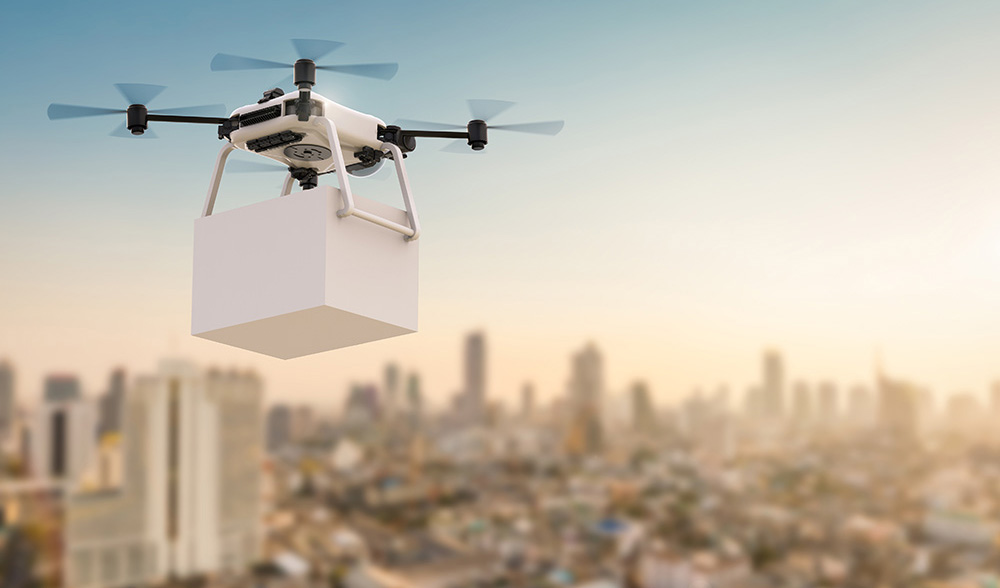
In the near future, networks comprising huge numbers of sensors will support an IoT/IoE society where everything will be connected via the Internet. Since 2016, TDK, a leading global electronic components and device manufacturer, has proactively pursued sensor-related M&As and enhanced its product and technology portfolio to include almost all sensors in non-optical fields. Moreover, it has formed a solid sensor business capable of responding to diverse market needs with sophisticated sensor fusions combining multiple sensors, ICs, and software. This article outlines various initiatives by TDK, which aims to become the world’s no. 1 sensor solution provider.
- Huge Advances in Electronic Devices Equipped with Microcomputers and Sensors
- Proactive M&As to Develop a Lineup Encompassing Non-Optical Sensors
- Materials Technology and Mass Production Techniques Are Crucial to Developing Compact High-Performance Sensors
- Addition of Hall Sensor Significantly Enhances Expanded TDK’s Magnetic Sensor Products and Technologies
- Rapid Increase in Demand for MEMS Sensors for the Coming IoT and IoE Era
Huge Advances in Electronic Devices Equipped with Microcomputers and Sensors
Various sensors are used in smartphones and tablets, household appliances, office automation equipment, automobiles, industrial equipment, and robots. As electronic equipment gains additional functionality and grows even smarter, sensors are becoming indispensable as key devices.
The term of sensor is relatively new in electronics, having come into general usage only in the 1970s. Until the 1960s, sensors were generally called detectors or transducers, as their role was to detect physical quantities of light, sound, heat, or pressure and convert them into electric signals.
Developments in IC technology in the 1970s led to installation of microcomputers in many types of equipment, and various sensors came into use to improve efficiency, convenience and safety. If we compare a microcomputer to the human brain, the sensors are the five senses, and the word “sensor” instantly caught on in general usage, supplanting the stiffer-sounding terms “detector” and “transducer.”
Going beyond the five senses, there are also sensors for physical sensations (movement, balance, and weight), such as acceleration sensors and gyro sensors. These include motion sensors in smartphones and play important roles in car navigation systems as well as in posture control for robots and drones. Sensors also come in a wide range of types detecting things beyond human perception such as magnetism, ultrasound, infrared rays, ultraviolet rays, and nuclear radiation.
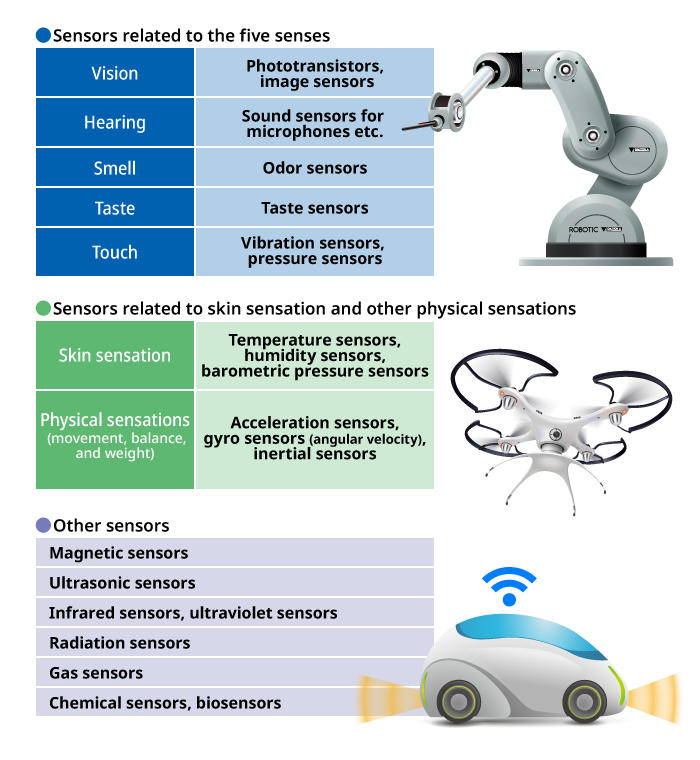
Proactive M&As to Develop a Lineup Encompassing Non-Optical Sensors
TDK was established in 1935 to launch industrial production of ferrite, an innovative magnetic material invented in Japan. In the 1970s the company developed cassette tapes that swept the world with high-quality music recording capabilities. In the 1980s, TDK contributed to miniaturization and weight reduction of electronic devices by commercializing multilayer chip products including multilayer inductors. Furthermore, in the 1990s, it contributed to dramatic increases in hard disk drive capacity by developing a magnetic head using sophisticated thin-film technology. TDK takes pride in having brought these
four great world-class innovations.
The driving force behind TDK’s development is achievement of nonlinear evolution coupled with relentless self-reform. In order to respond to the needs of the impending IoT and IoE society, since 2016 TDK has proactively engaged in sensor-related M&As and is currently devising bold strategies to become the world’s no. 1 sensor solution provider.
As of April 2019, TDK is advancing its sensor-related business in three business groups dealing with:
• magnetic sensors,
• temperature and pressure sensors, and
• MEMS sensors.
In 2017, the company formed a solid sensor business by establishing the Sensor System Business Company (SSBC) as a governing organization to oversee these business groups.
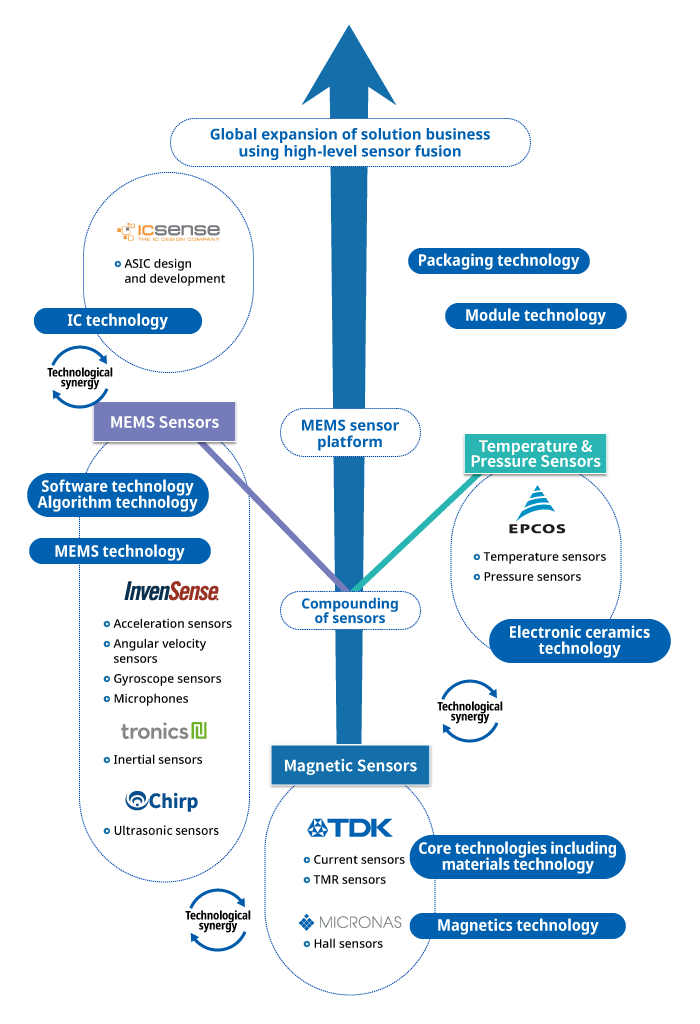
Materials Technology and Mass Production Techniques Are Crucial to Developing Compact High-Performance Sensors
A sensor is a component that utilizes the properties of a material and the phenomena it causes to produce electric signals. Major sensor materials include metals, alloys, intermetallic compounds, semiconductors (silicon, composite semiconductor, etc.), ceramics (magnetic, piezoelectric, semiconductor, pyroelectric, etc.), solid electrolytes, and organic polymers.
The principles and effects used in sensors include photoelectric effect (light → electricity), piezoelectric effect (pressure or sound → electricity), thermoelectric effect (heat → electricity), Hall effect, and magnetoresistance effect (magnetism → electricity). Many of these principles and effects were discovered in the 19th century, but development of practical sensor components with high sensitivity and high performance requires suitable materials and manufacturing methods. Such components also have to fulfill the requirements of being compact, highly reliable, affordable, and low in electricity consumption.
For example, NTC thermistors, which are frequently used as temperature sensors in household appliances, office automation equipment, and industrial equipment, utilize special semiconductor ceramics with a particularly high resistance variation rate caused by temperature. A material displaying thermistor properties was discovered by the English scientist Michael Faraday around 1833, but was not put into practical use as a temperature sensor for the first time until almost a century later, in the 1930s. Extremely sophisticated technologies and expertise are necessary to develop a temperature sensor with high reproducibility and stability, as even slight differences in material composition or manufacturing process will affect the properties of the material.
TDK has an extensive line-up of NTC thermistors under the TDK and EPCOS brands. Along with materials design technology and advanced ceramics technologies including sintering techniques, TDK utilizes its accumulated expertise in multilayer technology to develop multilayer ceramic capacitors for SMD chip-type products.
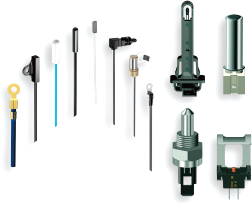
(NTC thermistors)
Addition of Hall Sensor Significantly Enhances Expanded TDK’s Magnetic Sensor Products and Technologies
Silicon, a material utilized in ICs and LSIs, is also used in various sensors. The Hall switches and linear Hall sensors supplied by TDK under the Micronas brand are magnetic sensors that use the Hall effect of semiconductors, which is a type of galvanomagnetic effect.
A characteristic of Hall sensors is that they can respond flexibly to diverse requirements such as detection of static and dynamic magnetic fields and discrimination of north and south magnetic poles. Hall switches are used for magnetic pole discrimination in brushless motors, and linear Hall sensors, which are capable of linear output, have a wide range of applications including angle sensors and position sensors.
Compound use of TMR Sensors and Hall Sensors
The addition of Hall sensors significantly enhanced TDK’s magnetic sensor products and technologies. TDK also developed an automotive angle sensor by combining its tunnel magneto-resistive (TMR) sensor, which boasts ultra-high sensitivity and high output, with a Hall sensor. This significantly improved redundancy (security and reliability), as it increased the probability of keeping at least one sensor functioning in harsh environments such as engine compartments.
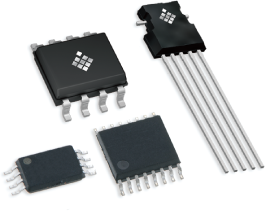
(TMR sensors and Hall sensors)
Rapid Increase in Demand for MEMS Sensors for the Coming IoT and IoE Era
Micro electro mechanical system (MEMS) technology, also known as micromachining technology, enabled ground-breaking innovations in miniaturization and mass production of sensors. Utilizing three-dimensional micro-fabrication technology used in the manufacture of ICs and LSIs, this technology enables integrated manufacturing of multiple items such as sensors, circuits, and moving parts on silicon wafers.
Research on MEMS technology began in the 1970s, and the first practical use of a MEMS sensor was a pressure sensor for automotive engine control. Subsequently, acceleration sensors for airbags and gyro sensors for safe driving were developed. In recent years, acceleration sensors and gyro sensors have frequently been used for applications such as MEMS microphones on smartphones, camera image stabilization, and motion tracking. Autorotation of smartphone display in response to handset movement is also enabled by acceleration sensors installed in the device.
MEMS sensors offer high-performance, high-added-value solutions
TDK’s MEMS sensors now offer high-level sensor fusions combining EPCOS brand pressure sensors with acceleration sensors and gyro sensors by InvenSense, which boast sophisticated design, inertial sensors by Tronics, and ultrasonic sensors from Chirp.
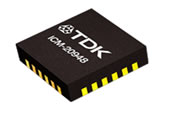
(3-axis gyro sensor, 3-axis acceleration sensor, and 3-axis electronic compass combined in a single package)
Packaging technology plays a crucial role in MEMS sensor miniaturization, reliability, and cost reduction. MEMS sensors are encapsulated in a wafer form prior to the process of dicing, in which they are made into chips. This is called wafer level packaging (WLP). While there are various methods, InvenSense’s Nasiri process is a unique technology in which the IC wafer etched with the circuit is vacuum sealed with the MEMS wafer on top and then electrically joined. InvenSense’s innovative MEMS sensors, including the world’s first dual axis gyro sensor, 3-axis gyro sensor, 6-axis motion sensor (3-axis gyro sensor and 3-axis acceleration sensor) and 9-axis motion sensor (3-axis gyro sensor, 3-axis acceleration sensor and 3-axis electronic compass) were developed using the Nasiri process.
TDK’s sensor platform, which integrates these advanced MEMS technologies, is expected to create high-added-value composite sensors and sensor solutions for the era of IoT and IoE.
Expectations for fusion with IC design and software technologies
Sensors do more than simply measure; they are evolving into intelligent sensors (smart sensors) and sensor modules combined with ICs including software and algorithms that process, analyze, and interpret information. The addition of ICsense, the top European manufacturer of application-specific integrated circuit (ASIC) designs, to the TDK Group has brought advanced IC design technology essential to devices that process signals obtained through sensing. The TDK Group anticipates technological synergies with InvenSense and other Group companies.
The global sensor market is rapidly expanding, and annual global sensor shipments are expected to exceed 1 trillion units in the 2020s, heralding the arrival of the “trillion-sensor society.” Future articles in this series will outline in detail TDK’s vast lineup of sensor products and technologies.

- Huge Advances in Electronic Devices Equipped with Microcomputers and Sensors
- Proactive M&As to Develop a Lineup Encompassing Non-Optical Sensors
- Materials Technology and Mass Production Techniques Are Crucial to Developing Compact High-Performance Sensors
- Addition of Hall Sensor Significantly Enhances Expanded TDK’s Magnetic Sensor Products and Technologies
- Rapid Increase in Demand for MEMS Sensors for the Coming IoT and IoE Era